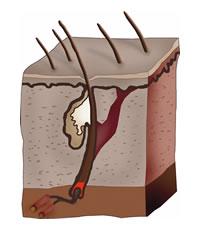|
When red headed people are above a certain social grade their hair is auburn. Mark Twain |
|
Hair transplantation can help both men and women
Hair loss: treatment and medicationThe most important cause of hair loss is inadequate nutrition. Even a partial lack of almost any nutrient may cause hair to fall. But hair grows normally after a liberal intake of these vitamins. A high protein and and an iron rich diet is recommended for hair loss. An adequate intake of raw vegetables, fresh fruits, salads, green leafy vegetables should be included in the diet on a regular basis. General debility, caused by severe or long standing illnesses like typhoid, syphilis, chronic cold, influenza and anaemia, also gives rise to hair disorders. It makes the roots of the hair weak, resulting in falling of hair. An unclean condition of the scalp can also cause loss of hair. This weakens the hair roots by blocking the pores with the collected dirt. Heredity is another predisposing factor which may cause hair to fall. Scalp reduction is performed on patients with well-defined bald spots in the crown area of the scalp. It is sometimes done in conjunction with hair transplantaion to reduce the size of the bald scalp, especially in patients who do not have enough donor hair to cover the bald areas. Silicon bags are inserted beneath an area of hairy scalp and gradually inflated with saline water over a six-week period. This causes the hair-bearing skin to stretch, thus increasing the amount of hair-bearing scalp. After removing the bags, expanded hair bearing skin is lifted and moved to an adjacent bald area where a similar sized patch of scalp has been excised. Male pattern baldness that is the condition responsible for over 98% of all hair loss in men. It gets its name from the pattern of hair loss, which ultimately results in a horseshoe of hair that resides on the sides and back of the head, while the top of the head is completely bald. Some men begin MPB by losing the hair in their hairline. Others start in the crown. The most familiar hair loss pattern is where the hair begins to recede in the hairline and the crown at roughly the same time. The hair in the mid-scalp or anterior scalp is often the last to go. But go it will, eventually leaving a man with the horseshoe of hair that is the telltale sign of typical male pattern baldness. For women, hair loss is different. There is no set pattern for womens androgenic hair loss, which like MPB, occurs in the overwhelming majority of cases. Women can suffer from alopecia totalis and alopecia universalis just like men. Women can experience patch baldness for the same reasons as men (stress, poor nutrition, etc.), as well as due to hormonal changes from pregnancy and certain eating disorders. However, like men, the hair will generally grow back. Finasteride (Propecia). This prescription medication to treat male-pattern baldness is taken daily in pill form. Many people taking finasteride experience a slowing of hair loss, and some may show some new hair growth. Positive results may take several months. Finasteride works by inhibiting the conversion of testosterone into dihydrotestosterone (DHT), a hormone that shrinks hair follicles and is an important factor in male hair loss. Rare side effects of finasteride include diminished sex drive and sexual function. As with minoxidil, the benefits of finasteride stop if you stop using it. Anthralin (Drithocreme). Available as either a cream or an ointment, anthralin is a synthetic, tarry substance that you apply to your scalp and wash off daily. It's typically used to treat psoriasis, but doctors can prescribe it to treat other skin conditions. Anthralin may stimulate new hair growth for cases of alopecia areata. Hair transplantationHair transplantation has come a long way from the days of "hair plugs" and a pleasing, natural result is now routine. It is an excellent option for treatment of hereditary hair loss in many men and women. Hair transplantation refers to the surgical movement of permanent hair with its roots to an area of bald or balding skin. Hair transplantation is an effective and permanent solution for hair loss. Hair transplantation is a surgical modality used for the correction of androgenic alopecia, scarring alopecia, and other causes of permanent alopecia. Hair transplantation can be done both on patients with advanced baldness and earlier thinning. Newer treatments for men like Propecia or for both men and women, like Rogaine should be considered as well especially in patients with earlier thinning as these medications often slow significantly the progression of hair loss. In general, hair transplantation is not considered for patients younger than their mid 20s because of difficulty in predicting ultimate extent of hair loss. Hair transplantation is universally accepted as a treatment for hair loss. While it was developed and first offered as a hair-loss treatment for men, women have increasingly found hair transplantation a viable option to correct the cosmetic deficit of thinning hair. Advances in hair transplantation techniques and better understanding of the biology of female hair loss contributed to the evolution of hair transplantation got women. Hair loss is not "an inevitable sign of getting older". It has been reported in studies that about 80% of women experience some degree of hair loss before menopause. Much of this hair loss has a hereditary basis-female pattern hair loss. Hair care useful tipsIt is good to shampoo your hair--we recommend at least three times a week. This helps to remove dirt and buildup on the hair that can deteriorate the condition of your scalp. When shampooing, it is very important that you pay attention to cleansing your hair, your scalp and your hair line. Blond hair may turn yellow, fade or become dull due to UV exposure. Even natural brunette hair tends to develop reddish hues from sun exposure due to oxidation of melanin pigments. Nutritionists advise healthy hair seekers to eat well-balanced diets that incorporate healthy proteins along with foods high in vitamins B, C, E, A and K. Hair instantly responds to the addition of protein-rich foods such as meats, eggs, cheese, seeds and nuts. Fish packs a double punch of protein combined with health building essential fatty acids and natural oils. We recommend you discuss your diet with a medical professional.
Definitions used on this pageScalp Improve yourself! Be interest!
|

